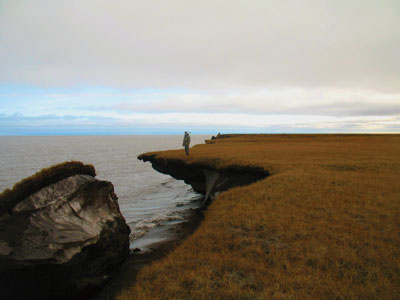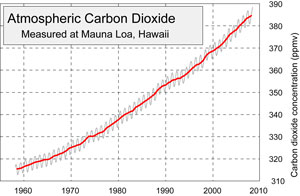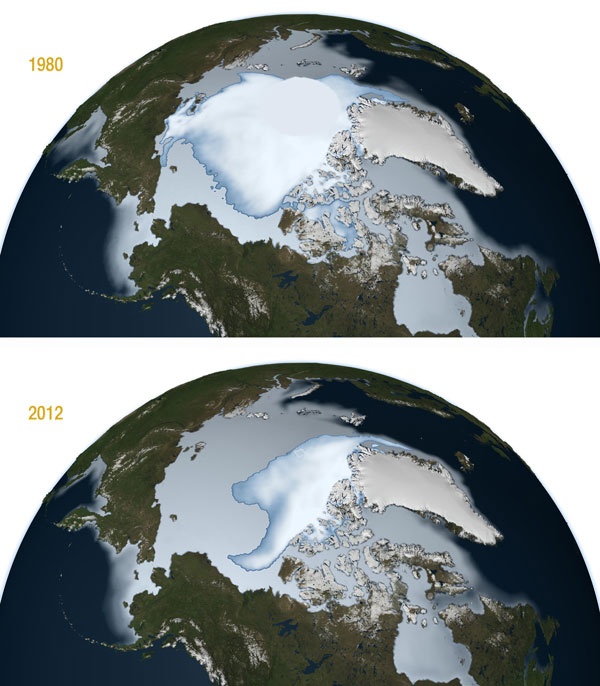An Urgent Climate Change Wake-Up Call
Carbon Dioxide Levels in the Atmosphere Hit 400 Parts per Million
May 26, 2013 | Revolution Newspaper | revcom.us

A large chunk of frozen soil—permafrost—in the Antarctic polar region that melted and detached from the land mass as a result of warming climate.
Photo: Courtesy U.S. Geological Survey
Scientists monitoring carbon dioxide (CO2) in the atmosphere announced May 9 that levels of CO2 had reached 400 parts per million (ppm). The measurements were taken at the Mauna Loa Observatory in Hawaii. CO2 levels haven't been this high for at least 3 million years.
CO2 is the predominant gas contributing to the "greenhouse effect"—warming the planet and bringing increasingly destructive climate change. It's produced by the burning of fossil fuels (like oil and coal) and by deforestation, which are central to the functioning of the global economy under capitalism-imperialism. In just the past 200+ years of industrialization, the amount CO2 has gone from around 280 ppm to its present level of 400 ppm.
This announcement should serve as a gut punch and a ringing wake-up call about the heightening emergency humanity is facing due to the warming of the planet, climate change, and the overall environmental destruction ravaging Earth. This announcement should shake people to their core. It should make them stand up and shout to others that we must do something—we must come into the streets; we must stop this. Not because the exact number 400 means more in itself than 399 or 401—but because this number, and the rate of increase of CO2, is a very dire indication that the planet's climate is being taken to dangerous places not previously seen in all of human history.
Each year, the world's big carbon polluters and dominant powers gather at international conferences and talk about climate change and its awful dangers. Each year, they agree something must be done, and then continue to do nothing of real substance to stop this. Instead, they race more aggressively to grab up new, more extreme and polluting sources of fossil fuels in their mad dash to outcompete each other for profits and control. And the planet warms—the Arctic ice cap melts, drought and starvation are worsened, and thousands more die in extreme weather events fueled by climate change. And who is the biggest contributor to the historic buildup of greenhouse gasses, and who continues to do the most to sabotage any meaningful changes? The U.S. leads the pack.
That the atmosphere's CO2 is at 400 ppm and rising is a howling outrage. Where are the calls and the actions to stop the drilling, digging, and burning of fossil fuels that are wrecking the environment and the future? Nowhere to be seen from those in power. Instead of seizing on this as an urgent moment to awaken and mobilize humanity, to stop fossil fuel burning, and bring forward safe energy technologies, the 400 ppm announcement is being treated by the powers-that-be and the mainstream media as one more piece of bad news, to be marked and moved on from.
Climate Change and the Environmental Emergency
Carbon Dioxide, the "Keeling Curve," and Climate Change
Every year since 1958—when measurements began at Mauna Loa—CO2 levels have increased. The measurements are displayed in a chart called the "Keeling curve" (see graphic). In 1958, CO2 was at 316 ppm. The increase from then till now looks like the teeth of a saw angled up—each spring the level is highest, it goes down in the summer as plants in the Northern Hemisphere absorb CO2, and next spring it's higher yet. In 2012, CO2 emissions increased by 2.6 percent over 2011—a new record amount of yearly emissions.

For at least the last 800,000 years, CO2 levels were less than 300 ppm. Scientists have learned about the CO2 history of the planet by drilling core samples from ice sheets in Greenland and Antarctica. From these, they can gather information on air temperature and CO2 levels. There are close connections between the levels of CO2 in the atmosphere and the temperature of the earth. When one goes up, the other goes up and when one falls, the other also falls. The British Antarctic survey that studies ice cores says, "temperature and CO2 are intimately linked, and each acts to amplify changes in the other (what we call a positive feedback)."
CO2 is the predominant greenhouse gas building up in the atmosphere and warming the earth. CO2, methane, water vapor, and some other greenhouse gasses occur naturally, and in a basic way they serve to keep the earth warm enough for life to exist—for plants and animals to live. Greenhouse gasses mainly allow visible sunlight to pass through them. When sunlight hits the earth, much of it is absorbed, but some of this energy is converted to heat that gives off longer wavelength infrared radiation that is reflected back into the atmosphere. Some of this heat radiation is partially absorbed by greenhouse gasses, which trap this radiation like a greenhouse, warm it, and send heat radiation back to the earth's surface, further warming the earth.
Since the start of the industrial age, the amount of greenhouse gasses in the atmosphere have been building up and causing increased warming. Greenhouse gasses are produced by the burning of coal, oil, and gas, by the cutting down and burning of forests and wood, by large-scale industrial agriculture, and other means.
CO2 levels this high have not been seen in at least 3 million years—since long before modern humans evolved. The earth at this time was a vastly different planet with very different ecosystems (webs of interacting life). Richard Norris, a paleobiologist with the Scripps Institute of Oceanography, said the last time CO2 was at 400 ppm, "There were camels and forests in the Arctic, the tropics were locked in a near constant El Niño—the kind that typically floods the western U.S.—and large expanses of the U.S. East Coast, Florida, and the Gulf States were underwater."
Humanity and earth's ecosystems—the webs of interacting life we depend on for our own existence—are facing a multi-dimensional environmental emergency. Forests and natural habitats are being destroyed and degraded; large numbers of species are being driven to extinction or threatened with extinction; water, air, and soils are being polluted and degraded. And because so much carbon has been spewed endlessly into the skies, the oceans' chemistry is being toxically transformed by sucking up that carbon.
Interacting with, and as a leading edge of, this destruction, climate change threatens to become unstoppable and runaway. In the last 12 months, we have seen the unprecedented scope and destruction of super-storm Sandy and many more extreme weather disasters—what used to be called anomalies—that have become the new normal. We've seen the droughts and wildfires of last summer in the U.S. and Russia in 2010, and the massive and unprecedented flooding in Pakistan in 2011. Before our eyes, Arctic ice and glaciers are disappearing. This global melt has immense ramifications for the world climate, for rich ecosystems, and for the water needs of huge segments of humanity.
Scientists say that we must turn away quickly from the massive burning of fossil fuels and transition to sustainable, non-carbon-based energy production if there is to be hope for any chance at stabilizing the climate. Most scientific experts say to avoid even more, and faster, disastrous climate change, world temperatures must be kept to no more than a 2-degree Celsius (3.6 degrees Fahrenheit) rise over temperatures of pre-industrial times. But even this may be too high, as we are already seeing huge changes with only the 0.8-degree Celsius temperature rise that has already occurred.
It's been estimated that the amount of carbon dioxide in the atmosphere that would produce a 2-degree Celsius rise is 450 ppm. Ralph Keeling of the Mauna Loa Observatory remarked, "At this pace, we'll hit 450 ppm within a few decades."
Climate change is taking an immense toll on humanity in many ways, but one of the most destructive is the impact on food supplies caused by increasing drought and extreme weather disasters. Recent studies indicate global warming played a part in the 2011 drought in Somalia that resulted in the deaths of 50,000-100,000 people. Food experts are predicting extreme and dire consequences for world food supplies from the heightening effects of climate change. The lives of potentially billions of people hang in the balance in all of this, including the ability to continue to survive in whole regions of Africa, Australia, on island and low-lying nations—like Bangladesh (due to sea-level rise) and other parts of the world. These impacts of climate change are already, and will increasingly be, the most severe for masses of people in the poor countries oppressed by the powerful capitalist-imperialist world.
Extinction of Species and Our Common Future
The cost of climate change to species worldwide is staggering—3,000 species a year are already going extinct because of destruction of habitat and climate change. This number could reach tens of thousands per year. It's been known for years that many endangered species are the most vulnerable. But a new study in the journal Nature Climate Change says that even common species are severely threatened by climate change. According to the Science Daily website, this research "looked at 50,000 globally widespread and common species and found that more than one-half of the plants and one-third of the animals will lose more than half of their climatic range by 2080 if nothing is done to reduce the amount of global warming and slow it down."
This means that geographic ranges of common plants and animals will shrink globally and biodiversity will decline almost everywhere.
Rachel Warren, one of the authors of the study, said, "This broader issue of potential range loss in widespread species is a serious concern as even small declines in these species can significantly disrupt ecosystems."
The pace of the current human-caused warming of the earth—and the climate change occurring because of it—is extremely rapid. Anthony Barnosky, University of California Berkeley professor of biology, says climate change "is racing faster than it ever has during the evolution of living species and ecosystems—many species simply aren't biologically capable of adjusting their geographic range at the speed they would need to in order to survive."
Warren pointed out that the health and survival of "common" species she studied was important to human well-being because these species affect "things like water and air purification, flood control, nutrient cycling and eco-tourism."
Humans exist on the basis of and in interaction with healthy, functioning, and diverse ecosystems. We rely on these ecosystems for air to breathe, water to drink, food, medicine, and natural recreation and appreciation. Without healthy, functioning, and sufficiently diverse ecosystems, humans as a species will not be long for this planet.
As we said in the special issue of Revolution, "State of Emergency," as bad as the destruction of species already occurring is, "this picture doesn't capture the deep threat to earth's biodiversity from many factors, and the degree to which entire ecosystems are being radically altered and in some cases already vanishing from the earth. There is real danger of a cascade of negative effects being set in motion that can affect the global health of the whole planet. ... Add up enough ecosystem collapses in local or regional scales and you can have collapse of the global ecosystem."
"If we don't hurry up and protect and preserve fast-vanishing natural ecosystems around the world, we will very likely witness before too long an unprecedented series of domino effects—a qualitative unraveling and degeneration of the natural world on this planet."
Think about it, modern human beings have been on the planet for roughly 200,000 years. And in all this time, in the short space of 200+ years, the workings of a particular economic system, capitalism, have brought the world to the brink of catastrophe. This world of environmental destruction, impoverishment, and oppression of huge swaths of humanity is, we are told, the "best of all possible worlds."
The reality is that a fundamentally and radically different world is possible.
We confront the need for a completely different way of producing energy, running our economies, and interacting with nature—a way that capitalism has proven repeatedly incapable of doing or even seriously addressing.
Rachel Warren, in commenting on the results of her study, said, "Prompt and stringent action to reduce greenhouse gas emissions globally would reduce these biodiversity losses by 60 percent if global emissions peak in 2016 or by 40 percent if emissions peak in 2030."
This is one indication at least that some of the worst impacts of climate change on causing species extinction may still be possible to prevent, or at least limit. But to do this, we must seize on this news of 400 ppm to wake people, to move humanity to resist all this starting now, and to increasingly connect this with the broader movement for revolution, which also must grow and impact all of society.

The Arctic ice cap in 1980 (above) and last year (below).
Image: NASA/Goddard Space Flight Center Scientific Visualization Studio
If you like this article, subscribe, donate to and sustain Revolution newspaper.
